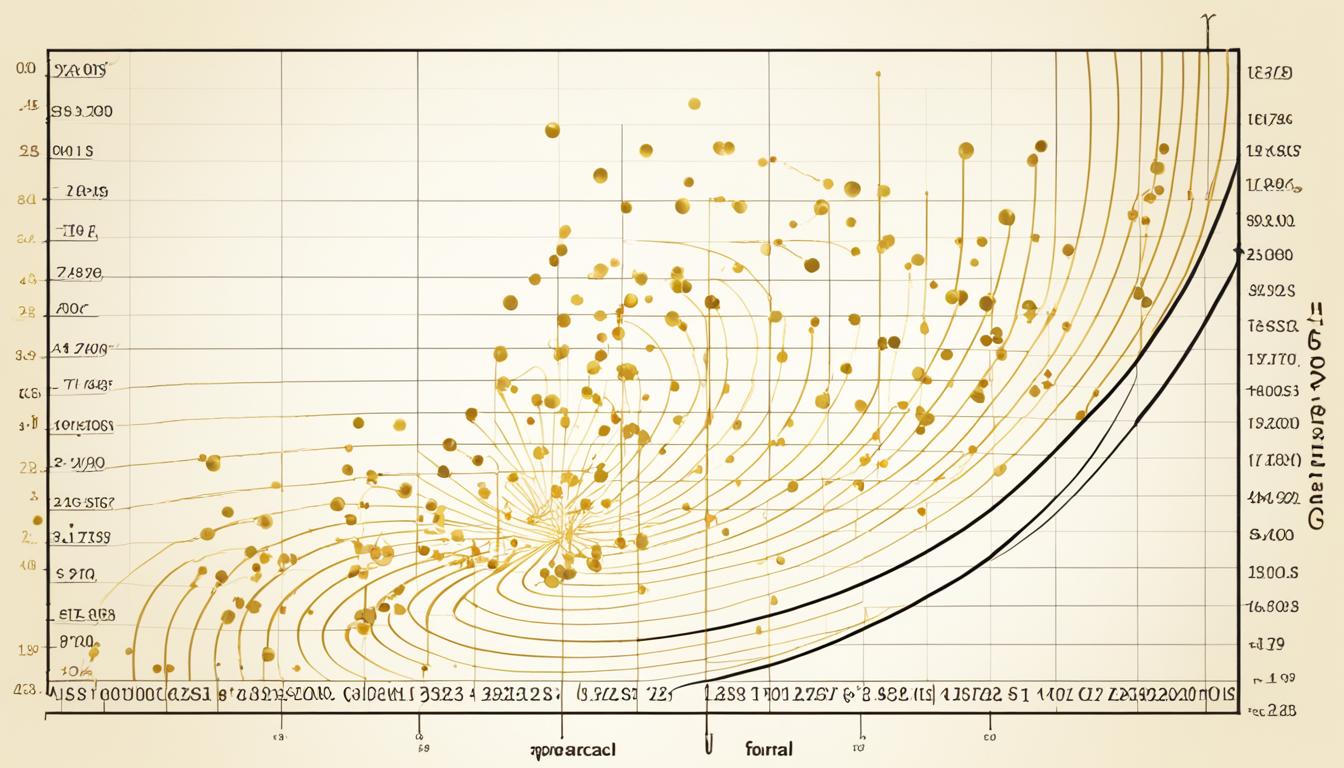Fibonacci retracements are key in technical analysis. They help traders spot where prices might turn around. Using the Fibonacci sequence, traders can make better choices. Adding a Fibonacci retracement strategy to your trading can really improve your predictions and actions.
Learning about Fibonacci trading helps traders see market moves better. It’s great for finding important support and resistance levels. It also predicts where prices might go next. Whether you’re new or experienced, using Fibonacci retracements can help you plan your trades better. It’s simple and works well in many markets.
Key Takeaways
- Fibonacci retracements help spot where prices might change direction.
- They are key for predicting market moves and making better decisions.
- Fibonacci trading shows important support and resistance levels.
- Using the Fibonacci retracement strategy makes trading more structured.
- This method works well in many market conditions.
Understanding Fibonacci Retracements in Trading
Fibonacci retracements are key in trading. They help spot where prices might turn around using past data. To get how they work, it’s important to know about the Fibonacci sequence. This is a series of numbers where each number is the sum of the two before it.
The Origin of Fibonacci Sequence
Leonardo of Pisa, known as Fibonacci, introduced the sequence in his 1202 book “Liber Abaci.” It starts with 0 and 1, and each next number is the sum of the two before. For instance, the sequence goes: 0, 1, 1, 2, 3, 5, 8, 13, and more.
This pattern is found in nature, art, and buildings. It’s the base for using it in financial markets.
Why Traders Use Fibonacci Retracements
Traders use Fibonacci retracements to find support and resistance levels. They draw lines at key points like 23.6%, 38.2%, 50%, 61.8%, and 78.6%. These levels help predict where prices might stop or change direction.
This tool is vital for finding when to buy or sell. It helps traders make better decisions and increase their profits.
How to Apply Fibonacci Retracement Levels
Learning to trade with Fibonacci retracements means following a step-by-step process. We’ll show you how to set up and use this tool. We’ll also talk about picking the right Fibonacci levels.
Setting Up Fibonacci Retracement Tools
To start, pick the Fibonacci retracement tool from your platform’s toolbar. Tools like MetaTrader 4, TradingView, and Thinkorswim make it easy to find. Here’s what to do next:
- Spot a strong trend in your asset.
- Click on the Fibonacci tool and set it at the trend’s start (high or low).
- Drag it to the trend’s end to see Fibonacci levels on your chart.
Make sure you check the placement carefully. Getting it right is key for good Fibonacci analysis.
Choosing the Correct Fibonacci Levels
Picking the right Fibonacci levels is crucial. The top levels are 23.6%, 38.2%, 50%, and 61.8%. Here’s what they mean:
- 23.6% Level: Shows a small pullback in a strong trend. Good for spotting minor corrections.
- 38.2% Level: Marks a moderate correction. Traders often set stop-loss orders just below this.
- 50% Level: At the midpoint, it often signals a big retracement. It’s a key level for traders.
- 61.8% Level: This level shows a deeper pullback. It’s seen as the last support or resistance point.
Using several levels helps you do a full Fibonacci analysis. This way, you can set clear entry and exit points. Remember, mistakes like wrong trend identification can lead to wrong retracement levels.
Effective Fibonacci Retracement Strategies
Using Fibonacci retracement patterns can make trading strategies better. By mixing these patterns with technical indicators, traders can make their analysis more precise. This helps in making better decisions. We will look at how to do this and give an example of a Fibonacci trade setup.
Combining Fibonacci Retracements with Other Indicators
To make Fibonacci retracement strategy more effective, it’s key to use it with other technical indicators. For example, moving averages, Relative Strength Index (RSI), and Moving Average Convergence Divergence (MACD) can be used. Here’s how:
- Moving Averages: Aligning Fibonacci retracement levels with key moving averages can provide stronger support and resistance points.
- RSI: Using RSI to check for overbought or oversold conditions at Fibonacci levels helps validate potential reversal points.
- MACD: Seeing MACD signals with Fibonacci retracement patterns can confirm the trend direction and momentum.
Example of a Fibonacci Trade Setup
Let’s look at an example. Suppose you’re looking at Apple’s stock price and see a recent peak. You draw Fibonacci retracement levels from the low to the peak, marking important levels (23.6%, 38.2%, 50%, 61.8%, and 78.6%).
If the price goes back to the 38.2% level and RSI shows it’s oversold, while MACD suggests buying, this is a strong sign to buy.
Common Pitfalls When Trading with Fibonacci Retracements
Trading with Fibonacci retracements is powerful, but it has its pitfalls. Traders need to watch out for these mistakes to improve their trading. Knowing how to avoid them can make a big difference.
One mistake is relying too much on Fibonacci levels without looking at the market overall. While Fibonacci can show where prices might turn, just using it alone can lead to bad decisions. It’s important to use Fibonacci with other tools and market analysis for better predictions.
Another error is misreading Fibonacci levels in volatile markets. These markets can make prices jump around, making it hard to spot reliable Fibonacci levels. Traders might think these jumps are signals, but they can lead to big losses. Being patient and using more tools can help in these situations.
Here are some tips to avoid these mistakes:
- Use Fibonacci with other indicators like moving averages or RSI.
- Think about the big picture and the economy.
- Be careful in unstable markets and don’t just focus on Fibonacci levels.
To make things clearer, here’s a table with common mistakes and how to avoid them:
| Common Pitfalls | Recommended Practices |
|---|---|
| Over-reliance on Fibonacci levels | Integrate with other indicators and market analysis |
| Misinterpreting levels in volatile conditions | Use additional validation tools and be patient |
| Ignoring broader market context | Consider macroeconomic factors and news events |
By knowing these mistakes and following best practices, traders can get better at using Fibonacci retracements. This can lead to more consistent results in their trading.
Conclusion
Learning to use Fibonacci retracements can greatly improve your trading skills. It helps you understand why these levels are important and how they can predict market moves. This knowledge makes it easier to know when to buy or sell.
Setting up Fibonacci tools correctly is key. Using them with other tools like moving averages can make your strategy stronger. Real examples show how these methods can lead to better trading results.
But, it’s important to watch out for mistakes to avoid losing money. Learning and practicing are crucial for using Fibonacci well in trading. With hard work, patience, and ongoing learning, you can get better at trading.
In short, Fibonacci retracements are a powerful tool for traders. By improving your skills and strategies, you can make your trading more effective. This can lead to more success in the financial markets.
FAQ
What is Fibonacci Retracement in trading?
Fibonacci retracement is a tool used by traders to spot where a trend might change. It marks key levels like 23.6%, 38.2%, 50%, 61.8%, and 100%. These levels can show where support or resistance might happen in a trend.
How does the Fibonacci Sequence relate to trading?
The Fibonacci sequence is a math pattern where each number is the sum of the two before it. This pattern helps traders find possible reversal points. Markets often move back to Fibonacci levels, making it useful for trading.
Why is the Fibonacci Retracement Tool important?
The Fibonacci retracement tool is key for traders. It helps them see where the market might turn. Using these levels can improve decisions on when to buy, sell, and set stop-losses.
How do you set up Fibonacci Retracement Tools?
To set up these tools, pick a high and low point on your chart. Most platforms have a Fibonacci retracement tool. Just mark these points, and the tool will show the Fibonacci levels.
Which Fibonacci levels should traders focus on?
Traders usually look at 38.2%, 50%, and 61.8% Fibonacci levels. These are key for spotting where a trend might change. They act as support or resistance in a trend.
How can Fibonacci levels be combined with other indicators?
Using Fibonacci levels with indicators like moving averages and RSI can give a fuller picture. These combinations help confirm if a trend will keep going or change, making trading decisions more accurate.
Can you provide an example of a Fibonacci trade setup?
Sure! Imagine a stock going up from 0 to 0. Using Fibonacci, you might see a level at 0 (38.2%). If other signs also suggest buying, you could trade there, expecting the trend to continue.
What are common mistakes when using Fibonacci retracements?
Traders often rely too much on Fibonacci without looking at other market factors. They might also pick the wrong high and low points or misread levels in volatile markets. Using different analysis methods can help avoid these mistakes.
Is Fibonacci retracement useful for all types of traders?
Yes, Fibonacci retracement helps all traders, from day traders to long-term investors. It’s useful for finding good entry and exit points, making it a key tool for many strategies.
How often do Fibonacci levels work in trading?
Fibonacci levels are highly respected but not always right. Their success depends on market conditions. Using them with other tools and staying disciplined can make them more useful.






